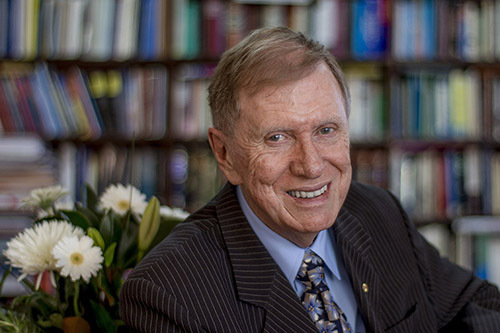
Sixty years to the day, the Honourable Michael Kirby AC CMG was admitted to the law in New South Wales. Atop his mountain of distinguished service to the legal profession, he surveys the legal landscape and reflects on the future.
He opens our conversation by referring to his presentation of the Boyer Lectures in 1983. The final lecture was entitled, ‘The Future’. Forty years later, many of his predictions have been realised including the ominous prediction, ‘The computer is about to enter judicial chambers; word processors are already there.’
Speaking today, he emphasises, ‘The future is not only about technology; it is not the whole story’. He elaborates, the future of law will be stimulated and enabled by technology. But the character of law is influenced by an intellectual process, not a computational process. Being the product of human endeavour, its substance is influenced by whether the minds of the legal profession are sufficiently ‘open’.
Reminiscing from his book-lined Macquarie Street Chambers, Michael Kirby identifies the cessation of appeals to the Privy Council of the United Kingdom as a radical change in Australian law in his lifetime. It paved the intellectual path of the future of the law in Australia. Glancing in the direction of his large but now somewhat dusty English law collection, he observes the drastic reduction of citation of English authorities in Australian cases – once its mainstay. Landmark Australian decisions such as Mabo could not have happened if Australia was still linked to the Privy Council; its decisions stood against the principle advanced by the majority in the Mabo decision.
In his view, an authentic commitment to diversity is central to a healthy intellectual process. Diversity in the legal profession needs to characterise the future of the law. Unless lawyers comprise a diversity of people and interact with a diversity of society, there will be a rigid mindset and the reach and value of law will be less.
Kirby observes the welcome emergence of a more questioning society. It contrasts to the era of his youth. Despite issues being close to his heart, for example, the disadvantages faced by women, gay rights, native title and the white Australia policy, in his student years, he did not raise his hand to question such laws. Reflecting the prevailing thinking of his era, he accepted what had been handed down by English judges – some 700 years of practice and procedure and the edifice of authority, stare decisis.
The future of law, he remarks, depends largely on the vigour of legal education. ‘If legal education is an unthinking reproduction of what has merely been, then young lawyers will be as timid or ignorant as I was when I was at law school’.
As a legendary guest presenter to thousands of law students, Kirby firmly encourages future lawyers to maintain a questioning mindset. The development of the intellectual process depends on law students and lawyers believing that there are some things that should change and can change. Law should be a profession of people who pride themselves in a tradition of being questioners who are ready to test propositions. It is beyond question that the pursuit of law must involve questioning. Dissent and argument are signs of a thinking institution, he notes.
He predicts that in years to come, society will look back on today and be distressed by some of our present laws. For example, the limited implementation of refugee conventions and the damaging effect of lengthy detention. Other areas of the law that might similarly be judged wanting are insufficient climate change regulation, the regulation of nuclear weapons and slaughter of animals. Seen in this way, the future of the law is already today’s responsibility.

Of his generation, Kirby pays considerable tribute to former Justice Brennan and other members of the High Court who formed the majority decisions in Mabo. They led a powerful shift in the intellectual mindset of lawyers. At the time, their reasoning was widely criticised as radical. In his view, they were ‘a few decades ahead of the rest of us. They found a key to unlock the door to 150 years of law. That key was the recognition of universal human rights.’ Kirby considers that the impact of universal human rights will be greater and much more explicit in the future, including the adoption of charters of rights more widely in Australia.
Echoing the views of the late Professor Julius Stone, Kirby observes that when the process of judicial reasoning presents the ‘leeway of choice’, the decision is imbued by the values and the background of the decision-maker. Law is not just an occupation of mechanically imposing a decision. These values are bestowed by various sources, such as one’s parents, education, siblings, religion, friends and community.
One of the strengths of our system is that judges can express differing views. He considers that if judges come from a greater diversity of life’s experiences, (for example, a range of educational backgrounds), those views might better appraise amore diverse set of perspectives. Necessarily, this will lead to increased empathy for different minority groups and a better understanding of the world in which the law operates. This should also satisfy a merit-based approach to judicial appointment because the worth of a functioning judiciary ought to be premised on its ability to empathise with, and understand, the lives before it in the process of making decisions.
The future of law must involve diversity being consciously acted upon. Michael Kirby predicts that Australian society will more widely accept that an institution such as the judiciary ought to be properly representative. It is important that courts are comprised of benches that ‘look a bit like the population’ rather than an elite minority. If everybody has the same view, it is generally going to be a very conservative institution, he reflects. Writing on the topic four decades ago, he similarly remarked that future judicial appointments will involve, ‘more women and more ethnics and more diversity generally on the bench reflecting the tremendous diversity of modern Australian society.’ That work is yet to be properly realised though some progress is afoot, including the recent appointment of the Hon Justice Dhanji, the first person of Indian descent, appointed to the Supreme Court of New South Wales. Unless the legal profession comprises lawyers of a more diverse background, the barrister and the judge of the future will be very similar to the barrister and judge of today and yesterday. Similarly views were recently expressed by former Chief Justice Bathurst. Michael Kirby observes a marked declined in orality at the Bar. The art of the advocate has increasingly shifted to written persuasion away from oral submission. Logistics indicate it is likely to be an increasing trend. He suggests that there are matters where barristers should press for oral applications because an oral submission tends to be more impactful and truly gets into the head of the decision- maker. Moreover, a paper submission does not readily invite question or clarification.
As he stated in the Boyer Lectures, Kirby foresaw the advent of intelligent computers: ‘Intelligent machines will learn methods of legal reasoning… [but] I do not see judges replaced by computers... Justice is a human quality. There is no computer with a will to do justice…’. He maintains his view that judicial decision-making will not be usurped by computers. Even if such technology could be programmed, society will not, and ought not, permit it. One only needs to reflect on the dystopian image of a decision-making algorithm being programmed by a particular governmental agenda. While human justice is imperfect, the benefits of decisions being made by an independent human mind far exceed any purported benefits of computer aided decisions (for example, efficiencies and consistencies). Plus, if mere consistency was the governing principle of decision-making, landmark decisions such as Mabo would not have been made because they required divergence from a series of much earlier decisions that pointed in the opposite direction.
Michael Kirby similarly opines that lawyers won’t be replaced by robots. In his view, it is healthy for society to have a professional group dedicated to challenging opinions on behalf of clients. Another Australian legal futurist, Nick Abrahams, who was also recently interviewed about the future of law, also rejects the notion that the future will see the ‘end of lawyers’. From a technology capability perspective, he says that legal decision-making is too complex for machines to replace lawyers in the foreseeable future. In his view, even a relatively standard commercial negotiation involves a level of complexity too high for artificial intelligence to grapple with.
Forty years ago, Michael Kirby correctly predicted, ‘Clients will also use computers in an endeavour to predict the outcome of litigation in order to decide whether it should be ventured.’ The birth of products such as Lex Machina performing predictive legal analytics make true this prediction. Mr Abrahams considers that such technologies are helpful data points and are increasingly demanded by commercial clients to aid dispute settlement.
Moving to more concrete matters, Abrahams considers the physical location of barristers in the future. But the topic does not particularly engage him. He considers it to be an introspective inquiry. By contrast, he suggests that a prospective way to think about the future of the law is to consider how barristers will serve their call and in sufficient number to enable reasonable access to justice. In other words, whether barristers work from Phillip Street or elsewhere does not really matter. The proper question is whether a barrister is continuing to fulfil the role of being a function of the court.
Michael Kirby acknowledges that there is already a widespread acceptance of the notion that one need not physically enter a court room to achieve justice. COVID-19 has demonstrated that even complex litigation can be ably facilitated by remote means. He sees remote means of accessing justice being increasingly explored in the future and notes that remote attendance might help to reduce the sometimes prohibitively expensive cost of litigation.
One of the few areas in which Kirby’s prediction from 40 years ago was somewhat less reliable was the continuing use of court attire. In 1983, he expected that court dress would ‘fade away’ by the turn of the century and ‘The horsehair wigs and the frock coats will be taken out of mothballs on ceremonial occasions as a reminder of the venerable antiquity of our legal system’. Reflecting on that now, he acknowledges that the accoutrements of the law have proved to be remarkably enduring. Today’s barristers and judges look practically the same as they did in the century before last and the one before that. But the subject of dress is not a priority to address. He reiterates, it is much more important to encourage a questioning mindset.
Without a doubt, the key to the future of the law is maintaining an open mind that politely asks, ‘Why?’. BN
